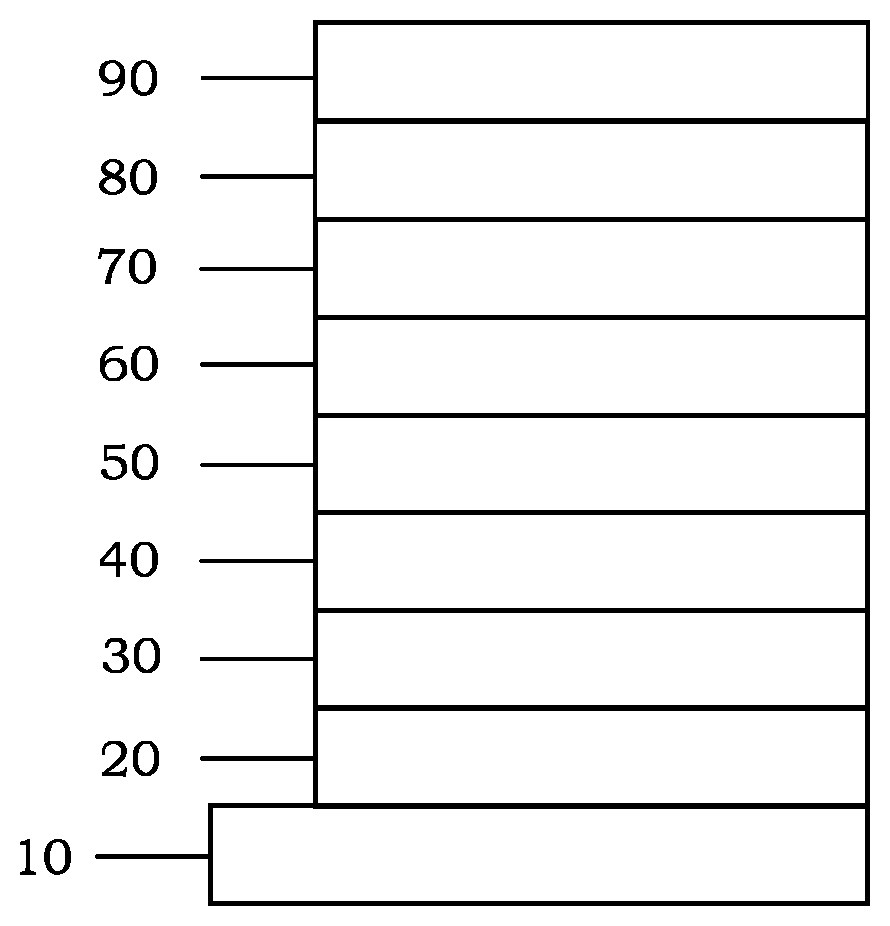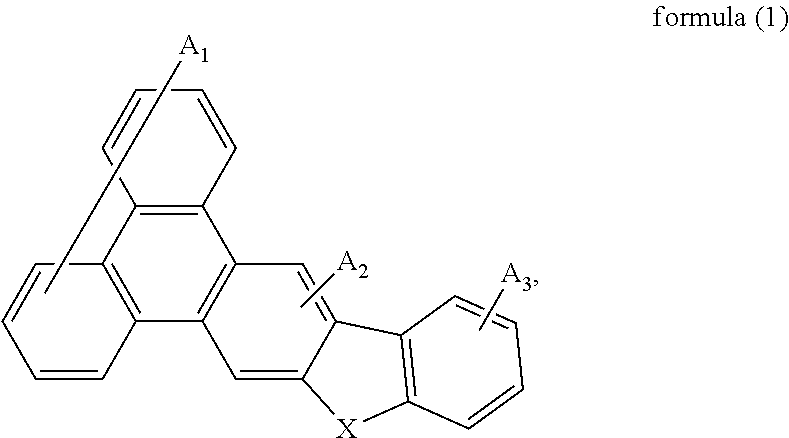Indenotriphenylene-based amine derivative and organic electroluminescence device using the same
a technology of indenotriphenylene and amine, which is applied in the direction of organic chemistry, solid-state devices, semiconductor devices, etc., can solve the problems of unsatisfactory driving voltage, current efficiency and half-life time of conventional materials used for phosphorescent guest in light emitting layer, such as metallic complexes, and achieves reduced voltage, longer half-life time, and higher current efficiency
- Summary
- Abstract
- Description
- Claims
- Application Information
AI Technical Summary
Benefits of technology
Problems solved by technology
Method used
Image
Examples
example 1
Synthesis of C1
[0020]Synthesis of Intermediate A
[0021]A mixture of 32.6 g (100 mmol) of 2,8-dibenzofuran, 21.8 g (110 mmol) of biphenyl-2-ylboronic acid, 2.31 g (2 mmol) of Pd(PPh3)4, 75 ml of 2M Na2CO3, 150 ml of EtOH and 300 ml of toluene was degassed and placed under nitrogen, and then heated at 100° C. for 12 h. After the reaction finished, the mixture was allowed to cool to room temperature. The organic layer was extracted with ethyl acetate and water, and then dried with anhydrous magnesium sulfate. The solvent was removed and the residue was purified by column chromatography on silica to give Intermediate A (24 g, 60%) as a white solid.
[0022]Synthesis of Intermediate B
[0023]In a 3000 ml three-necked flask that had been degassed and filled with nitrogen, 24 g (60 mmol) of Intermediate A was dissolved in anhydrous dichloromethane (1500 ml), and then 89.6 g (300 mmol) of Iron(III) chloride and 120 ml of Nitromethane was added. The mixture was stirred for one hour, and then 500 m...
example 2
Synthesis of C18
[0026]Synthesis of C18
[0027]In a 100 ml three-necked flask that had been degassed and filled with nitrogen, 3 g (7.55 mmol) of Intermediate B, 2.64 g (8.3 mmol) of N-(4-isopropylphenyl)dibenzothiophen-2-amine, 0.14 g (0.151 mmol) of Pd2(dba)3, 0.09 g (0.302 mmol) of tri-tert-butylphosphonium tetrafluoroborate, 1.5 g (15.1 mmol) of sodium tert-butoxide, and 60 ml of o-xylene were added, and then heated at 130° C. for 16 hours. After cooling to room temperature, the mixture was filtered to give a solid. The solid was washed with water and MeOH, and then filtered to give compound C18 (3.63 g, 76% as an off-white solid. MS (m / z, EI+): 633.81.
example 3
Synthesis of C167
[0028]Synthesis of Intermediate C
[0029]A mixture of 32.6 g (100 mmol) of 3,7-dibenzofuran, 21.8 g (110 mmol) of biphenyl-2-ylboronic acid, 2.31 g (2 mmol) of Pd(PPh3)4, 75 ml of 2M Na2CO3, 150 ml of EtOH and 300 ml of toluene was degassed and placed under nitrogen, and then heated at 100° C. for 12 h. After the reaction finished, the mixture was allowed to cool to room temperature. The organic layer was extracted with ethyl acetate and water, and then dried with anhydrous magnesium sulfate. The solvent was removed and the residue was purified by column chromatography on silica to give Intermediate C (26.8 g, 67%) as a white solid.
[0030]Synthesis of Intermediate D
[0031]In a 3000 ml three-necked flask that had been degassed and filled with nitrogen, 24 g (60 mmol) of Intermediate C was dissolved in anhydrous dichloromethane (1500 ml), and then 89.6 g (300 mmol) of Iron(III) chloride and 120 ml of Nitromethane were added. The mixture was stirred for one hour, and then ...
PUM
| Property | Measurement | Unit |
|---|---|---|
| internal quantum efficiency | aaaaa | aaaaa |
| internal quantum efficiency | aaaaa | aaaaa |
| temperature | aaaaa | aaaaa |
Abstract
Description
Claims
Application Information
 Login to View More
Login to View More - R&D
- Intellectual Property
- Life Sciences
- Materials
- Tech Scout
- Unparalleled Data Quality
- Higher Quality Content
- 60% Fewer Hallucinations
Browse by: Latest US Patents, China's latest patents, Technical Efficacy Thesaurus, Application Domain, Technology Topic, Popular Technical Reports.
© 2025 PatSnap. All rights reserved.Legal|Privacy policy|Modern Slavery Act Transparency Statement|Sitemap|About US| Contact US: help@patsnap.com



